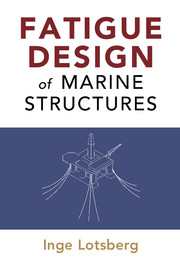Book contents
- Frontmatter
- Contents
- Preface
- Acknowledgments
- Introduction
- 1 Fatigue Degradation Mechanism and Failure Modes
- 2 Fatigue Testing and Assessment of Test Data
- 3 Fatigue Design Approaches
- 4 S-N Curves
- 5 Stresses in Plated Structures
- 6 Stress Concentration Factors for Tubular and Shell Structures Subjected to Axial Loads
- 7 Stresses at Welds in Pipelines, Risers, and Storage Tanks
- 8 Stress Concentration Factor for Joints
- 9 Finite Element Analysis
- 10 Fatigue Assessment Based on Stress Range Distributions
- 11 Fabrication
- 12 Probability of Fatigue Failure
- 13 Design of Bolted and Threaded Connections
- 14 Fatigue Analysis of Jacket Structures
- 15 Fatigue Analysis of Floating Platforms
- 16 Fracture Mechanics for Fatigue Crack Growth Analysis and Assessment of Fracture
- 17 Fatigue of Grouted Connections
- 18 Planning of In-Service Inspection for Fatigue Cracks
- APPENDIX A Examples of FatigueAnalysis
- APPENDIX B Stress Intensity Factors
- References
- Index
Preface
Published online by Cambridge University Press: 05 March 2016
- Frontmatter
- Contents
- Preface
- Acknowledgments
- Introduction
- 1 Fatigue Degradation Mechanism and Failure Modes
- 2 Fatigue Testing and Assessment of Test Data
- 3 Fatigue Design Approaches
- 4 S-N Curves
- 5 Stresses in Plated Structures
- 6 Stress Concentration Factors for Tubular and Shell Structures Subjected to Axial Loads
- 7 Stresses at Welds in Pipelines, Risers, and Storage Tanks
- 8 Stress Concentration Factor for Joints
- 9 Finite Element Analysis
- 10 Fatigue Assessment Based on Stress Range Distributions
- 11 Fabrication
- 12 Probability of Fatigue Failure
- 13 Design of Bolted and Threaded Connections
- 14 Fatigue Analysis of Jacket Structures
- 15 Fatigue Analysis of Floating Platforms
- 16 Fracture Mechanics for Fatigue Crack Growth Analysis and Assessment of Fracture
- 17 Fatigue of Grouted Connections
- 18 Planning of In-Service Inspection for Fatigue Cracks
- APPENDIX A Examples of FatigueAnalysis
- APPENDIX B Stress Intensity Factors
- References
- Index
Summary
This book is intended to act as a guide for students and practicing engineers for fatigue design of dynamically loaded marine structures. Fatigue of structures is a broad and complex area that requires more background than can be included in design standards. Many papers on fatigue of structures are published each year, and different design approaches have also been issued. However, due to the nature of the fatigue phenomena and scatter in test results, it may be difficult for engineers to obtain a good overview of what is found to be a good recommended fatigue assessment methodology.
The purpose of this book is not to give a complete overview of different design approaches, but rather to provide the reader with a sound background for the most common recommendations in design standards for fatigue assessment of marine structures. The content of this book is colored by the experiences by the author, and it may be relevant to consider this textbook in relation to the Standards with which the author has been most heavily involved, including the Recommended Practice DNVGL-RP-C203 Fatigue Design of Offshore Structures and DNV-RP-C206 Fatigue Methodology of Offshore Ships. However, similar content can also be found in a number of other design standards, such as: ISO 19902 (2007), API RP2A (2014), AWS (2010), BS 7608 (2014), Eurocode 3 (EN 1993–1–9, 2009), and IIW (Hobbacher, 2009). Thus, this book might best be considered as providing background for fatigue assessment of welded structures on a broad basis.
Based on the author's main background experience, a number of DNVGL standards are referenced. As these documents can be downloaded for free from the Internet, they are also useful reference documents for students studying fatigue of marine structures.
Much of this book is related to fatigue capacity of steel structures. The book may be seen as complementary to the Naess and Moan's book, Stochastic Dynamics of Marine Structures. Thus mainly the fatigue capacity of marine structures is considered in this book. The dynamic loading may be due to different sources such as waves, wind, rotors on wind turbines, dynamic response, vortex-induced vibrations, pile driving, and loading and unloading of content.
Information
- Type
- Chapter
- Information
- Fatigue Design of Marine Structures , pp. xvii - xxPublisher: Cambridge University PressPrint publication year: 2016
